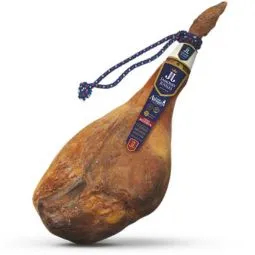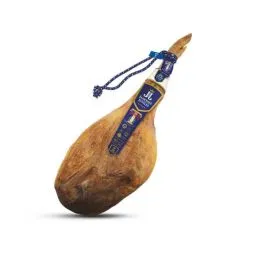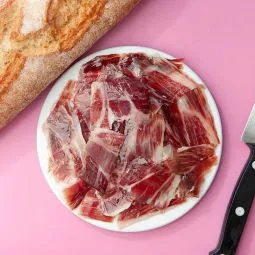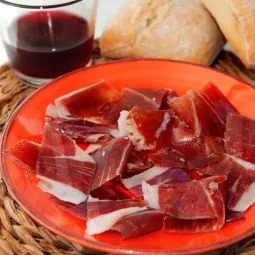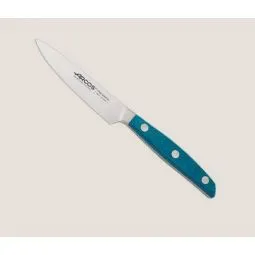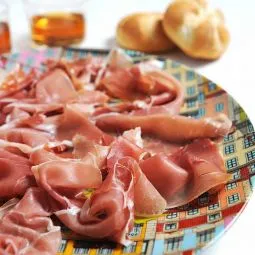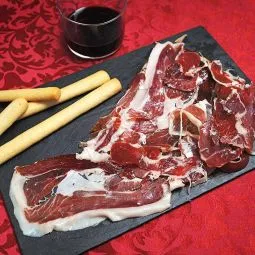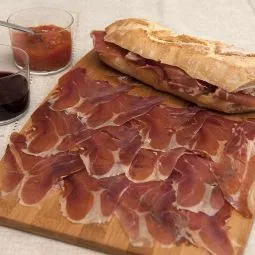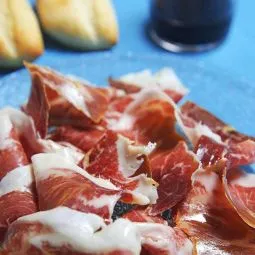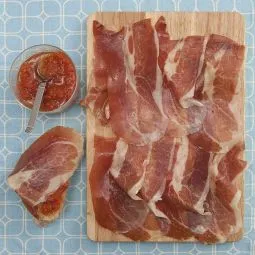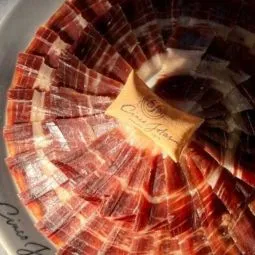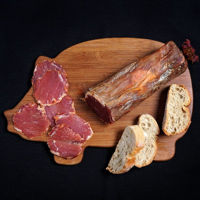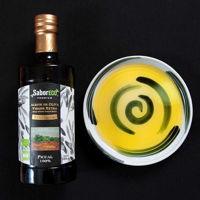15% HOT DISHES until:
ONLINE SPANISH HAM SHOP
Buy the best hams from Spain in the best online ham shop.
Buy our Spanish hams here:
See moreUse our advanced search
Trevelez Ham
- -5%
- -5%
Organic Iberian Shoulder Cut With A Knife
Pata Negra Bellota Ham Guijuelo Cut With Knife
Brooklyn Arcos Lace Knife
Serrano Pork Shoulder Sliced
Guijuelo Bellota Ham Sliced
Serrano Ham Reserva Sliced
Sliced Guijuelo Iberian Ham
Wooden Ham Holder
Sliced Teruel Ham
5 Jotas Ham Sliced
Which Spanish ham to buy?
When buying a Spanish ham, it is important that you know the product you are going to buy and the different hams you can find on the market.
First of all, it is important to remember that ham is obtained from the back of the pig. It weighs approximately 7 to 8.5 kg. Although sometimes you can find hams weighing up to 10kg. It has a bone to fat ratio of 50%.
In short, there are 2 types of ham, the ham that comes from the Iberian pig (Iberian ham) and the ham that comes from the white pig (Serrano ham). As you can see, we are referring to the breed of the animal, putting on one side the Iberian breed pigs and on the other side the rest of the pigs.
The conditioning factor of the breed is the one that will determine other key aspects that will differentiate one ham from another. These aspects are: the animal's diet, the curing time and the environment in which it has been reared, i.e., whether it has lived in captivity or in the wild. If you want to buy a Spanish ham leg, you are in the perfect online shop.
There is nothing like Spanish ham, we can find products that come from the same animal such as Italian ham or Austrian-German speck, but the curing process of Spanish ham is unique and gives rise to a unique product. It doesn't matter what Spanish ham lovers arround the world call it: "jamon ham", "Spanish prosciutto" or "Spanish jamón leg", they always refer to Spanish cured ham.
Types of cured ham that you can find in our shop
Spanish cured ham is considered to be those pork legs that have undergone a curing process based on salt and natural drying. It is the dame process for both the ham and the shoulders.
Iberian ham
Iberian ham is considered to be all hind legs from the Iberian pig, which have been cured and dried using the usual procedure and are certified by means of a label or seal around the ankle. The certification not only certifies the purity of the Iberian breed, but also determines the food the animal has been fed. An Iberian ham, regardless of its breed or diet, cannot be cured for less than 24 months.
Serrano ham
Serrano ham is considered to be all hams that are not certified as Iberian ham and have undergone a traditional curing and drying process. Unlike Iberian ham, Serrano ham is not certified as such. In some regions, producers have grouped together and created PDO’s and PGI associations, which guarantee the quality of the product and the good practices with which it has been produced. The production process is exactly the same, the difference is the breed of the pig.
Pork shoulder
Pork shoulder is considered to be the front legs of the pig. Within the pork shoulders, we can find serrano or Iberian shoulders, just like hams, the difference is that Iberian shoulders come from pigs of at least 50% Iberian breed and are certified. The rest of the pork shoulders, which are not Iberian shoulders, are considered serrano shoulders.
How to buy a good Spanish ham?
Now that you know the different types of Spanish ham, you can choose a ham that best suits your tastes and differentiate an Iberian ham from a Serrano ham, so that you don't take you for a ride.
It is very important that if you are looking for an Iberian ham that you are guaranteed that it is certified.
Morphologically, Iberian pigs differ from white pigs because they have a black hoof, but if it is not certified you will not know with certainty the feeding, breeding, breed and curing that this ham has had.
If you do not know the ham, seek advice. In Gastronomic Spain we have a chat service where we can answer any questions you may have.
How much does a ham cost at Gastronomic Spain?
At Gastronomic Spain we have a wide range of hams and shoulders, adapted to all tastes and pockets. One of the main advantages we offer is free transport to all parts of Europe. In Gastronomic Spain we offer you all types of Serrano and Iberian hams at a good quality / price ratio.
Are you looking for a cheap ham? or are you looking for the best ham in the world? we have what you are looking for. All the hams we have in our online shop are perfectly cured, so that you can enjoy this product to its full potential.
When choosing a ham, price is an important factor, but it should not be the determining factor. The most important thing when choosing a ham through an online shop, is to buy from an ecommerce with a good reputation, that has experience in the sale of these products and that has the means of communication where they can recommend the most suitable ham for your needs.
Gastronomic Spain is your trusted shop to buy a ham online.
Brands of Spanish hams in our shop
In Gastronomic Spain we work with the main protected designations of origin, Guijuelo, Jabugo, Dehesa de Extramadura and certified Serrano hams such as El Jamón de Teruel. All our hams are certified. Our main brands include: Eresma of the Copese Group and Jamones el Pozo.
On the other hand, we are aware of the local producers, who work with care the product and produce a more international ham, for that reason we work with some brands such as: Jamones Carbó, Jamones Nieto Martín, Extrem Ibérico and Jamones Sierra de Jabugo.
On the other hand, we work with the Extrem Ibérico brand, with all its hams, shoulders and Iberian sausages, to satisfy the most demanding consumer and offering a product that is more aware of the care of the animal, the environment and our own health.
